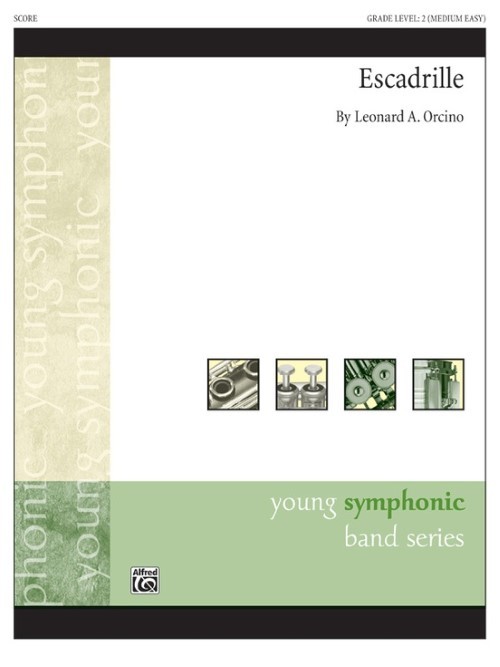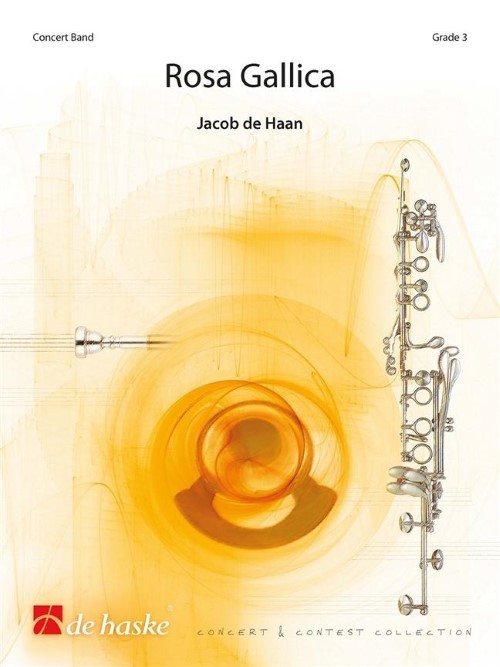Results
-
£81.99
The Greatest War Themes - Darrol Barry
Estimated dispatch 10-14 working days
-
£86.99
The War Of The Celts - Ronan Hardiman - Frank Bernaerts
Estimated dispatch 10-14 working days
-
 £57.00
£57.00War in the Chesapeake
A slow, solemn entrance; the haunting toll of a ship's bell; harmonic and rhythmic dissonances depicting tumultuous battle struggle; subtle references to The Star-Spangled Banner -these elements and more pay homage to the valor and sacrifice of those who fought bravely to defend liberty while capturing the indomitable spirit of a nation forged in the crucible of conflict.
Estimated dispatch 12-14 working days
-
£66.60
WAR MARCH OF THE PRIESTS - Mendelssohn Felix - Littlehales Peter
Estimated dispatch 7-14 working days
-
£44.60
WAR MARCH OF THE PRIESTS (Partitur/Score) - Mendelssohn Felix - Littlehales Peter
Estimated dispatch 7-14 working days
-
 £52.95
£52.95Escadrille (Concert Band - Score and Parts) - Orcino, Leonard A.
Early in World War I (1916), prior to the USA entering the conflict, Americans joined the French Air Corps. They were originally called the Escadrille Americaine and the name was changed to Escadrille de Lafayette after protest from the Germans that America was not in the war. The Escadrille had a reputation for daring recklessness and a party atmosphere. The corps mascots were two lion cubs, Whiskey and Soda. The insignia was an American Indian head with a flowing war bonnet. The entire squadron merged with the American Air corps (1918) once the USA entered the war.Duration: 2.30
Estimated dispatch 7-14 working days
-
 £137.99
£137.99Odyssee Wind Band Set (Score & Parts)
The Odyssee tells the story of Odysseus, the undaunted hero. In times long ago the blind poet Homer wrote this famous epic. The "Odyssey" follows the "Iliad", the story of the bloody war between the Greek and the Trojans. This battle ends after ten years thanks to the Odysseys famous trick. the Trojan Horse. The Odyssey is not a war epic, but a story about perseverance, loyalty, adventure, and the survival instinct of its ingenious hero. In The Odyssey, Homer describes how Odysseus, the king of Ithaca, had to endure another ten years of affliction after the ten years of war in Troy before he could finally return to his home land. During those years, his wife, Penelope, had to try and keep her many admirers away. These men not only wanted het hand but also the kingship. To prove her husbands worth, she played a trick: "As soon as I have finished weaving this shroud for my father-in-law, Laertes, I will choose one of you to become my husband", she promised them. But during the night, she secretly loosened what she had woven during the day, prolonging the time until Odysseus would finally return. After twenty long years, when he finally stood at the door, she wondered: Is this really my husband? Is he an imposter? Cunningly, she asked him to move the bed, because only she and her husband know that the bed was immovable and was build around an old three trunk! Odysseus was deeply moved: this really was his wife, his Penelope! Nearly three thousands years later, the loyalty and strength of this character, and all the dangerous adventures that Odysseus survived thanks to courage and intelligence, still moves us today. Odyssee by Jan Bosveld is not just an adventure story, but rather a characteristic piece in which memories of Homers story can be heard. The composition opens with a firm, stirring theme describing our hero, Odysseus, in detail: This man is not to be taken lightly. The further development of this short introduction completes this character sketch: trustworthy, perseverant, and a genius. After that we can picture Odysseus on the lonely beach of Ogygia. Do the trumpets depict his memories of the war of Troy? Does he think of his wife, as we recognise the weaving loom of Penelope in the murmuring eighth? In the solemn, plaintive part that follows, we can imagine Penelope feeling lonely, sitting in the womens room with her servants.One of the girls plays the harp, but that does not clear the sombre atmosphere. Then we can imagine seeing the sorceress Circe, who changed Odysseus men into swine. After she gives a simple magic sign something follows that reminds us of the sound of pigs grunting. Then the Odysseus theme resounds: the hero comes to savi his comrades. Assisted by Hermes, he forces Circe to lift the spell. The piece ends the same way as it began, with an animated theme: Odysseus is still the same, undefeated and not to be taken lighty! 07:45
Estimated dispatch 7-14 working days
-
 £137.99
£137.99Odyssee - Jan Bosveld
The Odyssee tells the story of Odysseus, the undaunted hero. In times long ago the blind poet Homer wrote this famous epic. The "Odyssey" follows the "Iliad", the story of the bloody war between the Greek and the Trojans. This battle endsafter ten years thanks to the Odysseys famous trick. the Trojan Horse. The Odyssey is not a war epic, but a story about perseverance, loyalty, adventure, and the survival instinct of its ingenious hero. In The Odyssey, Homer describes howOdysseus, the king of Ithaca, had to endure another ten years of affliction after the ten years of war in Troy before he could finally return to his home land. During those years, his wife, Penelope, had to try and keep her many admirers away.These men not only wanted het hand but also the kingship. To prove her husbands worth, she played a trick: "As soon as I have finished weaving this shroud for my father-in-law, Laertes, I will choose one of you to become my husband", she promisedthem. But during the night, she secretly loosened what she had woven during the day, prolonging the time until Odysseus would finally return. After twenty long years, when he finally stood at the door, she wondered: Is this really my husband? Ishe an imposter? Cunningly, she asked him to move the bed, because only she and her husband know that the bed was immovable and was build around an old three trunk! Odysseus was deeply moved: this really was his wife, his Penelope! Nearly threethousands years later, the loyalty and strength of this character, and all the dangerous adventures that Odysseus survived thanks to courage and intelligence, still moves us today. Odyssee by Jan Bosveld is not just an adventure story, butrather a characteristic piece in which memories of Homers story can be heard. The composition opens with a firm, stirring theme describing our hero, Odysseus, in detail: This man is not to be taken lightly. The further development of thisshort introduction completes this character sketch: trustworthy, perseverant, and a genius. After that we can picture Odysseus on the lonely beach of Ogygia. Do the trumpets depict his memories of the war of Troy? Does he think of his wife, as werecognise the weaving loom of Penelope in the murmuring eighth? In the solemn, plaintive part that follows, we can imagine Penelope feeling lonely, sitting in the womens room with her servants.One of the girls plays the harp, but that does notclear the sombre atmosphere. Then we can imagine seeing the sorceress Circe, who changed Odysseus men into swine. After she gives a simple magic sign something follows that reminds us of the sound of pigs grunting. Then the Odysseus theme resounds:the hero comes to savi his comrades. Assisted by Hermes, he forces Circe to lift the spell. The piece ends the same way as it began, with an animated theme: Odysseus is still the same, undefeated and not to be taken lighty!
Estimated dispatch 7-14 working days
-
 £82.50
£82.50Letters from the Battlefield - Barry E. Kopetz
Letters from the Battlefield was commissioned by the Land of Grant Honor Band to commemorate the end of the American Civil War. The collected letters of U.S. Grant reveal much information about the thoughts and emotions he was experiencing around the events of the Civil War. Some of the letters are tenderhearted, written in moments of sentimental passion; others are very clear and emphatic statements that he will do whatever it takes to bring the war to a close. The many moods and emotions expressed in his correspondence are reflected in the various sections of this powerful and moving work. An outstanding concert work, it is also appropriate for Civil War or patriotic commemorative ceremonies.
Estimated dispatch 7-14 working days
-
 £119.99
£119.99Rosa Gallica (Concert Band - Score and Parts) - De Haan, Jacob
Rosa Gallica has been written to commemorate the centenary of the First World War. The work focuses largely on France as a lot of the fighting took place there. With the title Rosa Gallica (French rose), the composer wishes to emphasize the poetic image of the rose. The stem represents the years gone by - such as those taken up by the First World War - and the thorns refer to the conflict and the pain that the victims had to endure. The rose itself forms the picture of beauty - and symbolises opening up to a peaceful world. The piece depicts France from the end of the 19th century through to its role at the heart of the First World War and beyond. A spectacular and dramatic new work by Jacob de Haan. Duration: 8.30
Estimated dispatch 7-14 working days
